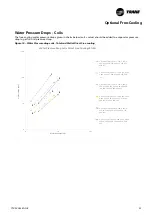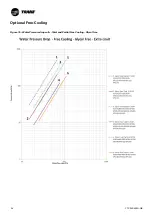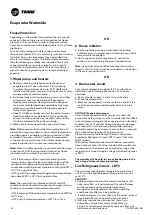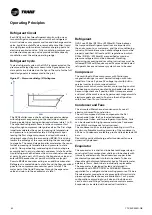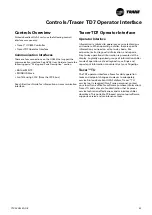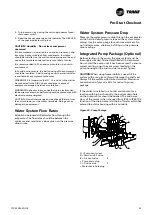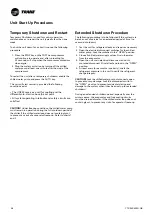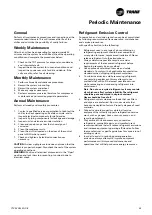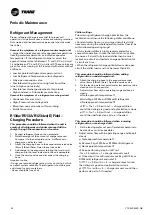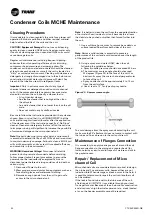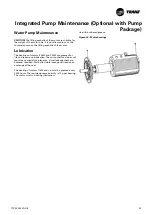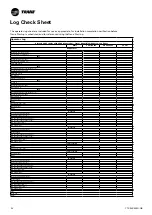
CTV-SVX009D-GB
47
11
UNT-PRC002-GB
Sound power levels
Discharge
Measurement conditions:
Measurements taken in a room adjacent to the room containing the FWD, at the outlet of the rectangular duct (1.5 m
long) fixed to its discharge opening.
Fan
Power level in dB(A), per Hz frequency band
Overall power
Unit
speed
125
250
500
1000
2000
4000
8000
dB(A)
1
55
50
42
37
37
31
30
46
FWD 08
2
57
54
47
40
30
38
40
50
3
58
57
50
42
32
40
43
53
1
57
51
45
42
34
33
28
48
FWD 10
2
58
54
48
45
38
39
35
51
3
60
58
50
48
40
42
39
54
1
57
51
45
42
34
33
28
48
FWD 12
2
58
54
48
45
38
39
35
51
3
60
58
50
48
40
42
39
54
1
56
62
50
48
39
38
36
56
FWD 14
2
61
66
55
53
47
46
45
60
3
63
69
58
56
50
50
49
63
1
57
63
51
49
40
39
37
57
FWD 20
2
61
66
55
53
47
46
45
60
3
63
69
58
56
50
50
49
63
Intake
Measurement conditions:
Measurements taken at the horizontal air intake.
Fan
Power level in dB(A), per Hz frequency band
Overall power
Unit
speed
125
250
500
1000
2000
4000
8000
dB(A)
1
56
55
55
53
46
45
42
57
FWD 08
2
63
62
60
60
53
53
53
64
3
66
65
63
62
56
55
57
67
1
62
58
55
58
51
48
44
61
FWD 10
2
66
63
60
62
56
55
52
66
3
70
67
63
65
59
59
57
69
1
62
58
55
58
51
48
44
61
FWD 12
2
66
63
60
62
56
55
52
66
3
70
67
63
65
59
59
57
69
1
66
65
65
65
57
50
46
68
FWD 14
2
73
72
69
71
64
59
57
74
3
78
76
73
75
69
64
63
78
1
68
72
64
64
56
52
50
69
FWD 20
2
76
76
68
71
65
61
61
75
3
78
79
71
74
69
66
66
78
Unit Start Up Procedures
Daily Unit Start Up
The timeline for the sequence of operation begins with a
power-up of the main power to the chiller. The sequence
assumes 2 circuits, with one or two compressors, Sintesis
Excellent GVAF chiller with no diagnostics or malfunctioning
components. External events such as the operator placing
the chiller in AUTO or STOP, chilled water flow through the
evaporator, and application of load to the chilled-water loop
causing loop water-temperature increases, are depicted
and the chiller responses to those events are shown, with
appropriate delays noted. The effects of diagnostics, and
other external interlocks other than evaporator water-flow
proving, are not considered.
Note: unless the UC800 TD7 and building automation system
are controlling the chilled-water pump, the manual unit start
sequence is as follows. Operator actions are noted.
General
If the present checkout, as discussed above, has been
completed, the unit is ready to start.
1. Press the STOP key on the TD7 display.
2. As necessary, adjust the set point values on the
TD7 menus using Tracer TU.
3. Close the fused-disconnect switch for the chilled-water
pump. Energize the pump(s) to start water circulation
4. Check the service valves on the discharge line, suction
line, oil line, and liquid line for each circuit. These
valves must be open (back seated) before starting the
compressors.
5. Verify that chilled-water pump runs for at least one
minute after the chiller is commanded to stop (for
normal chilled-water systems).
6. Press the AUTO key. If the chiller control calls for cooling,
and all safety interlocks are closed, the unit will start. The
compressor(s) will load and unload in response to the
leaving chilled – water temperature;
After the system has been operating for approximately 30
minutes and has become stabilized, complete the remaining
start up procedures, as follows:
1. Check the evaporator refrigerant pressure and the
condenser refrigerant pressure under Refrigerant Report
on the TD7.
2. Check the EXV sight glasses after enough time has
elapsed to stabilize the chiller. The refrigerant flow
through the sight glasses should be clear. Bubbles in
the refrigerant indicate either low refrigerant charge
or excessive pressure drop in the liquid line, or an
expansion valve that is stuck open. A restriction in
the line can sometimes be identified by a noticeable
temperature differential between the two sides of the
restriction. Frost will often form on the line at this point.
Proper refrigerant charges are shown in the General
Information Section;
3. Measure the system discharge superheat.
4. Clean the air filter located on the door of the control
panel of AFD if required.
Note:
The system cannot be pumped down due to the surge
characteristics of centrifugal compressors.
Inverted Start, commonly called “Monday Morning Start
Up”, can be a situation containing a high evaporation
load (high building heat inertia). This inertia may lead
to compressor capacity limitations due to choke at low
pressure ratio.
IMPORTANT NOTICE
- Do not use recycled refrigerant as it may contain oil, which
can affect system reliability. The refrigerant should be pure
and stored in virgin containers
- Hoses should be free of oil
- Do not attempt more than three restarts after a critical
fault. Continued attempts may cause the shaft to
degmagnetize. Please contact OEM service provider.
Seasonal Unit Startup Procedure
1. Close all valves and reinstall the drain plugs in the
evaporator.
2. Service the auxiliary equipment according to the startup
and maintenance instructions provided by the respective
equipment manufacturers.
3. Close the vents in the evaporator chilled-water circuits.
4. Open all the valves in the evaporator chilled-water
circuits.
5. Open all refrigerant valves.
6. If the evaporator was previously drained, vent and fill
the evaporator and chilled-water circuit. When all air is
removed from the system (including each pass), install
the vent plugs in the evaporator water boxes.
7. Check the adjustment and operation of each safety and
operating control.
8. Close all disconnect switches.
9. Refer to the sequence for daily unit start up for the
remainder of the seasonal start up.
System Restart after Extended
Shutdown
1. Verify that the liquid-line service valves, compressor
discharge service valves, and optional suction service
valves are open (back seated)
2. Fill the evaporator water circuit. Vent the system
while it is being filled. Open the vent on the top of the
evaporator while filling, and close it when filling is
completed.
3. Close the fused-disconnect switches that provide power
to the chilled-water pump.
4. Start the evaporator water pump and, while water is
circulating, inspect all piping for leakage. Make any
necessary repairs before starting the unit.
5. While the water is circulating, adjust the water flow and
check the water pressure drops through the evaporator.
Refer to “water-system flow rates” and “water-system
pressure drop”
6. Adjust the flow switch on the evaporator piping for
proper operation
7. Stop the water pump. The unit is now ready for startup
as described “Startup procedures”
CAUTION!
To prevent damage to the compressor, ensure that
all refrigerant valves are open before starting the unit. Do
not use untreated or improperly treated water. Equipment
damage may occur.

